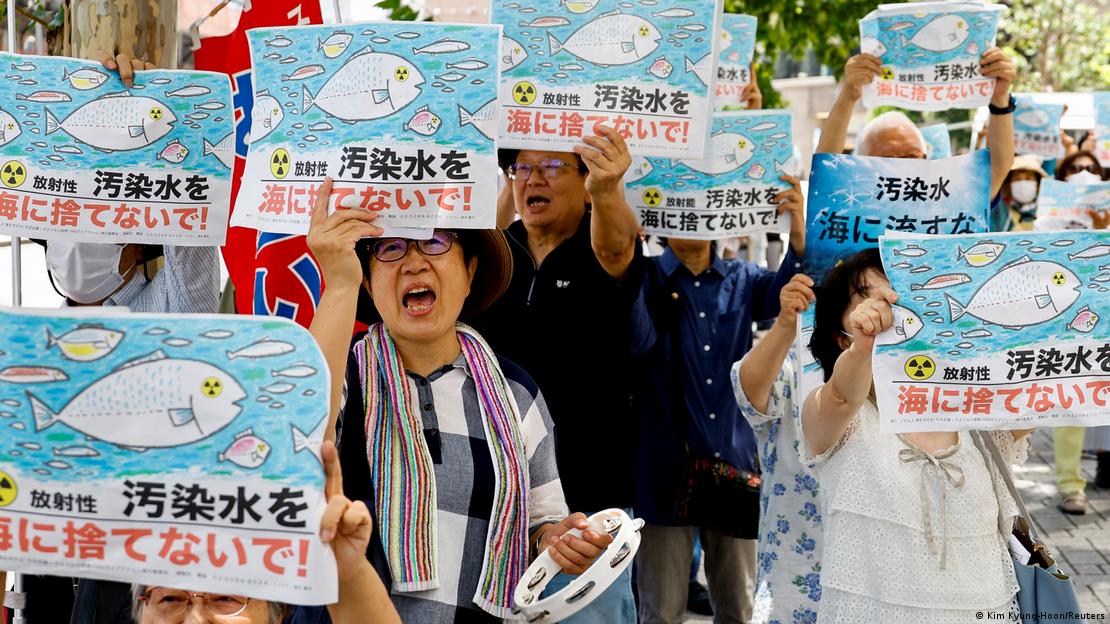The Japanese government, having apparently run out of storage space for the million tons of radioactively contaminated water have decided to pour it into the sea. This upsets a lot of people, including the governments of China and Korea, who understandably (on a moral level, perhaps) regard this decision as unacceptable. The Japanese (also the entire nuclear industry, plus the International Atomic Energy Agency, and a long list of self-identified experts) collectively say: no problems, the quantities are very small and pose no risk to health, neither to people nor marine life. The water has apparently been treated to remove the radioisotopes that the regulators believe pose the greatest risk, Strontium-90, Caesium-137, and Carbon-14. But to take out the Tritium is too expensive, and so the radioactive water is largely contaminated with large amounts of Tritium Oxide, in the form of Tritiated water HTO.
Tritium is the largest contaminant in terms of radioactivity, disintegrations per second, clicks on a counter, from the operation of all nuclear energy processes. The neutrons, which are central to nuclear energy, produce Tritium by various processes in reactors, and even outside reactors, where the nuclide, a radioactive form of Hydrogen, is formed by adding neutrons to nitrogen in the air, and oxygen in the water, various other processes. Tritium is interesting stuff. Its radioactivity is extremely weak: it emits a very short-range beta electron and itself then changes into Nitrogen. What? Yes, it is a form of hydrogen, but shoots off an electron and turns into nitrogen. But we are mostly made of hydrogen, you say. Just So.
In terms of radioactivity, because the decay electron is so weak, the method that the risk agencies use to quantify radiation effects has classed Tritium as almost a non-event, in terms of health effects. This is most convenient for the nuclear industry, as it means that the exposure limits for Tritium (in terms of Becquerels per litre) are truly enormous, when compared with other radioactive waste. Tritium has a 12-year half life, so it hangs about. And since all life depends on water, and indeed all life mostly is water, hydrogen and oxygen, introducing radioactive water into the environment might seem to be a bad idea.
But No! The low beta energy of Tritium allows the regulators to argue that the releases of huge amounts to the sea and rivers is safe. But the regulators are wrong. The system of analysis using the concept of “Absorbed Dose” is unscientific, dishonest and at the origin of a huge historic public health scandal that has caused hundreds of millions of deaths from cancer due to badly regulated releases of certain specific contaminants, and this includes Tritium, Carbon-14, Uranium (as particles) and certain other substances produced by nuclear processes. Many years ago, the regulator BEIR committee in USA under Prof Karl Z Morgan tried to change the limits for Tritium, but he was overruled because it would make the operation of nuclear power very difficult. He wrote about this in his book The Angry Genie. He was convinced that Tritium was a serious hazard.
So, lets look a bit closer at the quantities. The water in the tanks contains about 1500Bq/litre. A Becquerel is one decay per second. A litre of this water would produce 1500 clicks on a suitable measuring instrument (not a Geiger Counter, you won’t measure this stuff with a Geiger counter). Does that sound a lot? Would you drink this water? Even if the IAEA say it’s OK? Would They?
The total amount to be released is 1.3 million tons. Or we are told, 22 TeraBecquerel. That is 22,000,000,000,000Bq. Sounds a lot. It is a lot. But of course, the Pacific Ocean is large, and hopefully it will just go away through dilution. And it seems 22TBq, is small compared with the quantities released by the nuclear reprocessing plants in Europe. Sellafield in the UK pumped out 432 TBq a year (20 times more) to the Irish Sea and La Hague in France 10,000TBq/y (450 times). So that’s OK then. The experts say (and you can Google them on the Science Media Centre), or you can believe the IAEA, or the Japanese, that this stuff has never shown any health effects in places where it is poured into the sea.
Wrong.
I have spent a lot of my research life on looking at the effects of releasing radionuclides including Tritium to the sea. I spent three years in the late 1990s looking at cancer and child leukemia near the Irish Sea supported by the Irish State. Tritium is measured in surface water. This water is driven inshore to be inhaled by populations living within 1km of the sea. The radionuclides concentrate in the coastal sediment which is also driven ashore. You find the Tritium in fish, in shellfish, in blackberries, everywhere near the Irish Sea, near the Bristol Channel. My Irish Sea study looked at small areas of Wales between 1974 and 1990 and found a clear and significant sea coast effect on cancer, particularly childhood cancer. I also, from, 1999 to 2006 studied cancer near the Bristol Channel, where there are also significant quantities of Tritium, and again, found a distinct increase in cancer near the sea. About 30% near the coast. That is a lot of dead people.
I also studied leukemia in populations living near the nuclear submarine dockyard in Plymouth. Nuclear submarines are contaminated with Tritium and Carbon 14. They released it to the River Tamar and it ended up in the sediment. There was a significant leukemia cluster near the dockyard. This nuclear submarine operation was moved to Scotland some years ago. The Navy have a licence from the Scottish Environmental Protection Agency to discharge Carbon-14 and Tritium (1 million Becquerels a year from about 8 submarines). I have shown in a published paper in 2017 that sailors in nuclear ships in the USA Navy have a 10-fold excess risk of cancer.
There is another clincher: Professor Awadhesh Jha (who I met in Plymouth when I gave my report on the leukemia study, together with the UK Environment Minister Mr Michael Meacher) has studied the effects of Tritium on the genetic development of marine invertebrates living in the Tamar mud. Very small amounts of Tritium have profound effects of chromosomes and on development in these creatures. You can Google his research.
This is a big subject. But one I have studied in some depth. I was expert witness on a case in Korea some ten year ago where I was asked to advise the Korean parliament on the health effects of Tritium. The Koreans use the Canadian CANDU reactors which emit huge amounts of Tritium; there is a big cancer cluster around these sites.
Tritium is very dangerous. It gets inside you easily. It exchanges with normal hydrogen, sometimes it becomes organically (covalently) bound. It causes genetic damage at tiny conventional doses (calculated using the energy per unit mass, Joule/Kg formula of the International Commission on Radiological Protection, employed by the IAEA). Those people living near the seaside near the east coast of Japan, especially the estuaries, need to watch out. Don’t eat anything from the sea, or inside 1km from the coast. The radiation risk model that regulates Tritium is obsolete and wildly incorrect. The experts that say there are no effects in populations living near Tritium contamination need to look out of the window.
Finally, I was told something fascinating about Tritium by a colleague from Germany in 1998. Tritiated water has a much higher freezing point than ordinary water. So, when a fog appears as the air temperature drops. The initial fog is a pure Tritiated water vapour.
But I want to add something here. We have heard a lot about fake news. But there are scientists out there spinning the issue of radiation and health to levels of hysterical nonsense. An outfit called the Science Media Centre was set up by one Fiona Fox in the early 2000s. It was an operation intended to support the polluters and contaminators by fielding dishonest scientists posing as experts to head off media stories about public health hazards. In examining this issue of Fukushima and the Tritium, I could not fail to google up three of these “experts” writing for the Science Media Centre on the issue. Tracking down their qualifications and experience as “experts” or their affiliations, was not hard—you can do this yourself. The funniest of the three was a certain Associate Professor Nigel Marks of Curtin University, Perth (What?? Where??). Nigel tells us that on the basis of dose (and I suppose he has done the sums) that a “lifetimes worth of seafood from Fukushima is the radiation equivalent of one bite of a banana”. I am not going to unpack this nonsense—just to point out that it is wrong, dishonest, absurd and tendentious. And to warn everyone against these scientists. The web is stuffed full of them. The ordinary people are correct to view them as idiots, and to ignore everything they say. Nuclear industry science is cartoon science, based on nonsense, and supported by twisted epidemiology. It is now dead in the water. But not before it has historically killed hundreds of millions of people.















